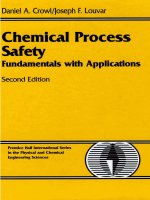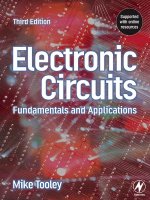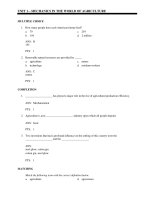Preview Engineering Chemistry Fundamentals and Applications, 2nd Edition by Shikha Agarwal (2019)
Bạn đang xem bản rút gọn của tài liệu. Xem và tải ngay bản đầy đủ của tài liệu tại đây (4.44 MB, 130 trang )
Engineering Chemistry
Engineering chemistry discusses fundamental theoretical concepts of chemistry and links them with their
engineering applications. First and second semester engineering students in various technical universities
study the subject, and this textbook has been designed to meet their course requirements in a comprehensive
manner. It supplements its treatment of the fundamental concepts and their applications by scores of
illustrations and learning exercises. Lucid language and an easy-to-learn approach will enable the readers to
assimilate the basic concepts and also facilitate comprehension by students not so strong in English language
skills. This revised, second, edition builds on the success and popularity of the first 2015 edition, which was
adopted as a text/reference book by several universities.
In addition to the topics in the first edition, this edition deals with new topics such as a detailed discussion
of renewable energy sources, nuclear fuels, defluoridation of water by Nalgonda technique and domestic
waste water management, periodic properties including classification of elements, periodicity in properties
and types of elements on the basis of their electronic configuration, periodic trends in properties like atomic
and ionic radii, ionisation enthalpy, electron gain enthalpy, electronegativity, Fajan’s rule and oxidation states
of elements of various groups, different theories of acids and bases like the Arrhenius theory, Bronsted–Lowry
concept, solvent system definition of acids and bases, Lewis concept, hard–soft acids and bases, oxidation and
reduction with its applications to the extraction of metals, Ellingham diagram, molecular interactions, real
gases and critical phenomenon, topics on quantum chemistry such as Schrodinger wave equation, particle in a
one- and three-dimensional box, Schrodinger wave equation for hydrogen and hydrogen-like system, Huckel
molecular orbital theory for conjugated system, semiconductors, superconductors and magnetic materials,
potential energy of surfaces, trajectories on potential energy surfaces, thermodynamic formulation of the
transition state theory, topics related to molecular spectroscopy like the Franck–Condon principle, rotational
(microwave) spectroscopy of diatomic molecules, vibrational rotational spectra of diatomic molecules,
Raman spectroscopy and applications of NMR spectroscopy in magnetic resonance imaging, drugs, absolute
configuration of organic compounds, coordination chemistry, nomenclature of coordination compounds,
bonding and isomerism in coordination compounds. The chapter on basics of environment science has been
removed in this edition.
Shikha Agarwal is an Assistant Professor in the Department of Chemistry, Government Engineering College,
Ajmer, India. She has more than two decades’ experience teaching engineering chemistry, environment
science, spectroscopy, photo-chemistry and reaction mechanism to undergraduate and graduate students.
Her areas of interest include organic chemistry, inorganic chemistry, and environment science.
Engineering Chemistry
Fundamentals and Applications
Second Edition
Shikha Agarwal
University Printing House, Cambridge CB2 8BS, United Kingdom
One Liberty Plaza, 20th Floor, New York, NY 10006, USA
477 Williamstown Road, Port Melbourne, vic 3207, Australia
314 to 321, 3rd Floor, Plot No.3, Splendor Forum, Jasola District Centre, New Delhi 110025, India
79 Anson Road, #06–04/06, Singapore 079906
Cambridge University Press is part of the University of Cambridge.
It furthers the University’s mission by disseminating knowledge in the pursuit of
education, learning and research at the highest international levels of excellence.
www.cambridge.org
Information on this title: www.cambridge.org/9781108724449
© Cambridge University Press 2015
This publication is in copyright. Subject to statutory exception
and to the provisions of relevant collective licensing agreements,
no reproduction of any part may take place without the written
permission of Cambridge University Press.
First published 2015
Second edition 2019
Printed in India
A catalogue record for this publication is available from the British Library
ISBN 978-1-108-72444-9 Paperback
Cambridge University Press has no responsibility for the persistence or accuracy
of URLs for external or third-party internet websites referred to in this publication,
and does not guarantee that any content on such websites is, or will remain,
accurate or appropriate.
To
His Holiness Shri Shivkripanand Swami
Contents
Preface to Second Edition
Preface to First Edition
Acknowledgements
xix
xxi
xxv
1.
Fuels
1.1
1.2
1.3
1.4
1.5
1.6
1.7
1.8
1.9
1.10
1.11
1.12
1.13
1.14
1.15
1.16
1.17
1.18
1.19
1.20
1.21
1.22
Introduction
Classification of Fuels
Characteristics of a Good Fuel
Calorific Value
Determination of Calorific Value
Solid Fuels
Analysis of Coal
Carbonisation of Coal
Liquid Fuels
Refining of Petroleum
Cracking
Synthetic Petrol
Knocking
Octane Rating
Diesel Engine Fuels
Knocking in Diesel Engine
Cetane Rating/Cetane Number
Reforming
Non Petroleum Fuels, Power Alcohol and Aviation Fuel
Gaseous Fuels
Natural Gas
Compressed Natural Gas (CNG)
1
1
1
2
4
6
16
17
29
35
36
38
41
45
47
48
48
49
49
51
53
53
54
1.23
Liquified Petroleum Gas
54
viii
Contents
1.24 Coal Gas
1.25 Oil Gas
1.26 Producer Gas
1.27 Water Gas
1.28 Analysis of Flue Gas
1.29 Combustion Calculations
1.30 Renewable Sources of Energy
1.31 Nuclear Fuels
Summary
Review Questions
Multiple Choice Questions
55
56
57
59
60
62
75
87
94
96
98
2. Water
2.1
Introduction
2.2
Sources of Water
2.3
Effect of Water on Rocks and Minerals
2.4
Common Impurities of Water
2.5
Water Quality Standards
2.6
Hardness of Water
2.7
Disadvantages of Hard Water
2.8
Water for Industries
2.9
Boiler Problems with Hard Water
2.10 Softening Methods: External Treatment Process
2.11 Municipal Water Supply
2.12 Desalination of Water
2.13 Defluoridation
2.14 Waste Water Management
2.15 Chemical Analysis of Water
Summary
Review Questions
Multiple Choice Questions
103
103
104
105
106
108
111
119
120
122
130
156
163
167
169
173
203
205
206
3.
209
209
209
210
217
224
225
Corrosion
3.1
Introduction
3.2
Effects of Corrosion
3.3
Theories/Mechanism of Corrosion
3.4
Types of Corrosion
3.5
Passivity
3.6
Galvanic Series
Contents
4.
5.
ix
3.7
Factors Influencing Corrosion
3.8
Protection against Corrosion (Corrosion Control)
3.9
Methods of Application of Metal Coatings
3.10 Electroplating
3.11 Electroless Plating
Summary
Review Questions
Multiple Choice Questions
226
228
235
239
245
248
250
251
Phase Rule
255
4.1
Introduction
4.2
Explanation of Terms
4.3
Phase Diagram
4.4
Water System
4.5
Sulphur System
4.6
Two-Component Systems
4.7
Construction of Phase Diagrams
4.8
Lead–Silver System
4.9
Zinc–Magnesium System
4.10 Iron–Carbon Alloy System
4.11 Metal and Alloys
4.12 Properties of Metals
4.13 Alloys
4.14 Purpose of Making Alloys
4.15 Classification of Alloys
4.16 Special Effects of Alloying Elements
4.17 Alloy Steels and Their Applications
4.18 Non-Ferrous Alloys
4.19 Heat Treatment of Steel
Summary
Review Questions
Multiple Choice Questions
255
255
263
264
266
269
270
273
277
280
287
287
290
290
291
293
294
297
300
302
303
304
Engineering Materials
5.1
Cement
5.2
Gypsum (CaSO4.2H2O)
5.3
Plaster of Paris (2CaSO4.H2O or CaSO4.½H2O)
5.4
Lime
5.5
Glass
307
307
318
318
319
320
x
Contents
5.6
Refractories
5.7
Abrasives
5.8
Insulating Materials
Summary
Review Questions
Multiple Choice Questions
330
340
342
345
347
349
6.
Polymers
6.1
Introduction
6.2
Classification of Polymers
6.3
Functionality
6.4
Mechanism of Polymerisation
6.5
Polymerisation Techniques
6.6
Molecular Weight of Polymers
6.7
Plastics
6.8
Individual Polymers
6.9
Rubbers (Elastomers)
6.10 Fibres
6.11 Speciality Polymers
6.12 Properties of Polymers
6.13 Degradation of Polymer
6.14 Polymer Composites
6.15 Adhesives
Summary
Review Questions
Multiple Choice Questions
352
352
352
358
359
367
368
371
376
387
393
400
408
416
418
421
423
425
426
7.
Lubricants
7.1
Introduction
7.2
Functions of Lubricants
7.3
Mechanism of Lubrication
7.4
Classification of Lubricants
7.5
Synthetic Lubricants
7.6
Lubricating Emulsions
7.7
Properties of Lubricants
7.8
Selection of Lubricants for Different Types of Machinery
Summary
Review Questions
Multiple Choice Questions
431
431
432
432
436
440
441
442
450
451
452
453
Contents
8. Periodic Properties
8.1
Introduction
8.2
Basic Concepts
8.3
Periodicity in Properties
8.4
Types of Elements on the Basis of Their Electronic Configuration
8.5
Periodic Trends in Properties of Elements
8.6
Ionisation Enthalpy
8.7
Electron Gain Enthalpy
9.
xi
455
455
455
459
460
461
465
467
8.8
Electronegativity
8.9
Polarising Power and Polarisability: Fajan’s Rule
8.10 Oxidation State
Summary
Review Questions
Multiple Choice Questions
469
473
475
477
478
478
Acid–base, Oxidation–Reduction and Intermolecular Forces
9.1
Introduction
9.2
Arrhenius Concept
9.3
Bronsted–Lowry Concept
9.4
The Solvent System Definition of Acids and Bases
9.5
Lewis Concept of Acid and Base
9.6
Hard Soft Acids and Bases
9.7
Solubility Equilibria
9.8
Common Ion Effect
9.9
Oxidation and Reduction
9.10 Oxidation Number (Oxidation State)
9.11 Application of Principles of Oxidation and Reduction in Metallurgy
9.12 Ellingham Diagram: Thermodynamical Aspect of the Reduction Process
9.13 Molecular Interactions
9.14 Real Gases and Critical Phenomenon
Summary
Review Questions
Multiple Choice Questions
481
481
481
482
485
486
488
491
493
495
495
496
499
502
505
510
511
511
10. Atomic Structure and Chemical Bonding
10.1 Introduction
10.2 Dual Nature of Radiation
10.3 Dual Nature of Matter: de Broglie Equation
10.4 Heisenberg’s Uncertainty Principle
515
515
516
516
522
xii
Contents
10.5 Schrodinger Wave Equation
10.6 Particle in a One Dimensional Box
10.7 Particle in a Three Dimensional Box
10.8 Schrodinger Wave Equation for Hydrogen and Hydrogen-Like System
10.9 Huckel Molecular Orbital (HMO) Theory for Conjugate System
10.10 Chemical Bonding
10.11 Hybridisation of Orbitals
10.12 Molecular Orbital Theory
10.13 Bonding in Metals – Metallic Bond
Summary
Review Questions
Multiple Choice Questions
525
529
535
538
544
553
554
567
586
592
593
595
11. Solid State
11.1 Introduction
11.2 Types of Solids
11.3 Crystal Lattice and Unit Cell
11.4 Bravais Lattice
11.5 Types of Unit Cells and Number of Atoms per Unit Cell
11.6 Packing of Crystals
11.7 Interstitial Sites or Interstitial Voids
11.8 Coordination Number and Radius Ratio
11.9 Packing Efficiency and Atomic Radius
11.10 Calculation of Density of a Crystal from Its Edge Length
11.11 Braggs Law: X-Ray Study of Crystals
11.12 Structures of Simple Ionic Compounds
11.13 Imperfection in Solids
11.14 Semiconductors
11.15 Superconductors
11.16 Magnetic Materials
11.17 Fullerenes
11.18 Graphite
Summary
Review Questions
Multiple Choice Questions
599
599
599
601
602
604
606
609
609
612
616
620
622
628
631
643
648
649
651
652
653
654
12. Liquid Crystals
12.1 Introduction
12.2 Characteristics of Liquid Crystals
658
658
659
Contents
xiii
12.3 Classification of Liquid Crystals
Summary
Review Questions
Multiple Choice Questions
660
665
665
666
13. Chemical Kinetics
13.1 Introduction
13.2 Rate of Reaction
13.3 Average Rate and Instantaneous Rate
668
668
669
672
13.4 Rate Law Expression
13.5 Velocity Constant or Rate Constant
13.6 Factors Influencing Reaction Rate
13.7 Reaction Mechanism
13.8 Order and Molecularity of Reaction
13.9 Kinetic Equation of Different Orders/Integrated Rate Reactions
13.10 Half-life of a Reaction
13.11 Methods of Determining the Order of a Reaction
13.12 Concept of Activation Energy
13.13 Variation of Reaction Rates with Temperature – Arrhenius Equation
13.14 Theories of Reaction Rates
13.15 Potential Energy of Surfaces
13.16 Catalysis
Summary
Review Questions
Additional Problems
Multiple Choice Questions
14. Surface Chemistry
14.1 Introduction
14.2 Adsorption
14.3 Factors Affecting Adsorption
14.4 Types of Adsorption
14.5 Type of Adsorption Isotherms
14.6 Applications of Adsorption
14.7 Colloidal State
14.8 Classification of Colloids
14.9 Preparation of Colloids
14.10 Purification of Colloidal Solutions
14.11 Properties of Colloidal Solutions
675
676
677
678
681
686
706
711
720
722
727
732
738
745
748
750
753
757
757
757
759
761
762
767
768
770
773
777
778
xiv
Contents
14.12 Stability of Colloids
14.13 Protective Colloids
14.14 Emulsion
14.15 Micelles
14.16 Applications of Colloids
Summary
Review Questions
Multiple Choice Questions
15. Thermodynamics
15.1 Introduction
15.2 Terminology of Thermodynamics
15.3 Zeroth Law of Thermodynamics
15.4 First Law of Thermodynamics
15.5 Heat Capacity
15.6 The First Law of Thermodynamics and Ideal Gases
15.7 Isothermal Processes in Ideal Gases
15.8 Adiabatic Processes in Ideal Gases
15.9 Applications of First Law of Thermodynamics
15.10 Laws of Thermochemistry
15.11 Kirchhoff’s Equation
15.12 Joule–Thomson Effect
15.13 Limitations of the First Law: Need for the Second Law
15.14 Statements of the Second Law of Thermodynamics
15.15 Entropy
15.16 Second Law of Thermodynamics in Terms of Entropy
15.17 Evaluation of Entropy
15.18 Entropy Changes in a Reversible Process
15.19 Entropy Change in a Irreversible Process
15.20 Entropy of Mixing
15.21 Free Energy Function (G) and Work Function(A)
15.22 Gibbs–Helmholtz Equation
15.23 Claypeyron–Clausius Equation
15.24 Vant Hoff Isotherm
15.25 Maxwell’s Thermodynamic Relations
15.26 Spontaneity and Equilibrium
Summary
Review Questions
Multiple Choice Questions
783
783
784
786
787
788
788
789
793
793
793
798
798
811
813
816
818
827
830
834
838
840
841
847
848
850
856
857
858
861
866
868
871
873
875
878
883
885
Contents
16. Electrochemistry
16.1 Introduction
16.2 Types of Conductors
16.3 Conductance in Electrolytic Solutions
16.4 Factors Affecting Conductance
16.5 Kohlrausch’s Law of Independent Migration of Ions
16.6 Conductometric Titration
16.7 Electrochemical Cell
16.8 Electrode Potential and EMF of a Galvanic Cell
16.9 Measurement of Electrode Potential
16.10 Electrochemical Series
16.11 Nernst Equation
16.12 Thermodynamic Functions and Electrochemical Cells
16.13 Types of Electrodes
16.14 Determination of Fluoride by Ion Selective Electrode Method
16.15 Determination of pH
16.16 Concentration Cells
16.17 Batteries
16.18 Fuel Cells
Summary
Review Questions
Multiple Choice Questions
xv
890
890
890
891
898
900
904
908
910
912
913
918
925
928
934
936
942
945
952
957
963
965
17. Spectroscopy
17.1 Introduction
17.2 Basic Terms and Principles of Spectroscopy
17.3 Electronic (UV–Visible) Spectroscopy
17.4 IR Spectroscopy
17.5 Rotational Spectroscopy of Diatomic Molecules
17.6 Vibrational–Rotational Spectra for a Diatomic Molecule
17.7 Nuclear Magnetic Resonance Spectroscopy
17.8 Raman Spectroscopy
Summary
Review Questions
Multiple Choice Questions
968
968
968
977
989
1007
1014
1015
1032
1037
1040
1042
18. Photochemistry
18.1 Introduction
18.2 Significance of Photochemistry
1047
1047
1048
xvi
Contents
18.3 Laws Governing Light Absorption
18.4 Laws of Photochemistry
18.5 Quantum Yield or Quantum Efficiency
18.6 Electronic Excitation
18.7 Jablonski Diagram
18.8 Photophysical Processes
18.9 Photosensitisation
18.10 Semiconductor Photochemistry
18.11 Supramolecular Chemistry
18.12 Supramolecular Photochemistry
18.13 Introduction to Optical Sensors
Summary
Review Questions
Multiple Choice Questions
1049
1049
1051
1056
1056
1058
1060
1061
1064
1067
1070
1073
1074
1075
19. Fundamentals of Organic Chemistry
19.1 Introduction
19.2 Cleavage of Covalent Bonds
19.3 Attacking Reagents
19.4 Electron Displacements in Covalent Bonds
19.5 Reaction Intermediates
19.6 Types of Organic Reactions
19.7 Mechanism of Nucleophilic Substitution Reactions
19.8 Mechanism of Electrophilic Substitution Reactions
19.9 Mechanism of Elimination Reactions
19.10 Important Name Reactions
19.11 Stereochemistry
19.12 Drugs
Summary
Review Questions
Multiple Choice Questions
1077
1077
1077
1078
1080
1093
1103
1109
1115
1121
1124
1133
1150
1152
1156
1158
20. Coordination Chemistry
20.1 Introduction
20.2 Terms Used in Coordination Chemistry
20.3 Nomenclature of Coordination Compounds
20.4 Isomerism in Coordination Compounds
20.5 Bonding in Coordination Compounds: Werner’s Coordination Theory
20.6 Sidgwick Coordination Theory
20.7 Valence Bond Theory
1163
1163
1164
1165
1168
1173
1175
1176
Contents
20.8 Crystal Field Theory
20.9 Molecular Orbital Theory
Summary
Review Questions
Multiple Choice Questions
xvii
1180
1188
1193
1194
1196
21. Organometallic Compounds
21.1 Introduction
21.2 General Methods of Preparation
21.3 Applications of Organometallics
21.4 Grignard Reagents
Summary
Important Dates in Organometallic Chemistry
Review Questions
Multiple Choice Questions
1198
1198
1200
1202
1205
1214
1214
1214
1215
22. Green Chemistry
22.1 Introduction
22.2 Emergence of Green Chemistry
22.3 Twelve Principles of Green Chemistry
22.4 Use of Alternative Feedstock (Biofuels)
22.5 Use of Innocuous Reagents
22.6 Use of Alternative Solvents
22.7 Design of Safer Chemicals
22.8 Designing Alternative Reaction Methodology
22.9 Minimising Energy Consumption
Summary
Review Questions
Multiple Choice Questions
1217
1217
1218
1218
1221
1223
1223
1225
1226
1228
1231
1231
1232
23. Nanochemistry
23.1 Introduction
23.2 Properties of Nanomaterials
23.3 Self-assembly
23.4 Preparation of Nanomaterials
23.5 Nanomaterials
23.6 Surface Characterisation Techniques
23.7 Applications of Nanomaterials
Summary
Review Questions
Multiple Choice Questions
1234
1234
1236
1236
1242
1244
1251
1252
1255
1256
1257
xviii
Contents
24. Chemical Aspects of Biotechnology
24.1 Introduction
24.2 Applications of Biotechnology
24.3 Biocatalysts or Enzymes
24.4 Fermentation
24.5 General Outline of the Fermentation Process
Summary
Review Questions
Multiple Choice Questions
1259
1259
1259
1264
1265
1266
1273
1273
1274
25. Analytical Techniques in Chemistry
25.1 Introduction
25.2 Type of Analysis
25.3 Separation Techniques
25.4 Potentiometry
25.5 pH metry
Summary
Review Questions
Multiple Choice Questions
1276
1276
1276
1279
1280
1283
1285
1285
1286
26. Chemistry of Carbon and Hydrogen
26.1 Hydrogen
26.2 Preparation of Hydrogen
26.3 Industrial Method of Preparation of Hydrogen
26.4 Properties of Hydrogen
26.5 Isotopes of Hydrogen
26.6 Storage of Hydrogen
26.7 Compounds of Hydrogen
26.8 Applications of Hydrogen
26.9 Carbon
26.10 Isotopes
26.11 Allotropes of Carbon
26.12 Chemical Properties of Carbon
26.13 Uses
Summary
Review Questions
Multiple Choice Questions
Index
1287
1287
1287
1288
1289
1290
1291
1292
1297
1297
1297
1298
1299
1300
1300
1301
1301
1303
Preface to Second Edition
The wide popularity and acceptance of the first edition was the main motivation behind the second
edition. The first edition found its place as a text/reference book in the syllabus of several universities.
Several improvements have been made in this edition; the obscurities in the earlier edition have been
removed and several new topics have been added as per the AICTE model curriculum.
In Chapter 1, ‘Fuels’, the portion on renewable energy sources, which was just touched upon in the
first edition, has been elaborately written; a descriptive study of nuclear fuels has been added along
with chemical fuels. Chapter 2, ‘Water’, includes many new topics such as break point chlorination,
defluoridation of water by Nalgonda technique and domestic waste water management. Chapter 3,
‘Corrosion’, has been revised. Several figures have been replaced and a myriad of examples on different
types of corrosion both from day-to-day life and from industry have been introduced. Chapter 4, ‘Phase
Rule’, the iron–carbon alloy system has been rewritten. Chapter 8, ‘Periodic Properties’, and Chapter
9, ‘Acid–Base, Oxidation–Reduction and Intermolecular Forces’, are new to this edition. Chapter 8
deals with the basic concepts of classification of elements, periodicity in properties, types of elements
on the basis of their electronic configuration, periodic trends in properties like atomic and ionic radii,
ionisation enthalpy, electron gain enthalpy, electronegativity, Fajan’s rule and oxidation states of
elements of various groups; Chapter 9 discusses the different theories of acids and bases such as the
Arrhenius theory, Bronsted–Lowry concept, solvent system definition of acids and bases, Lewis concept,
hard–soft acids and bases, oxidation and reduction with its applications to the extraction of metals,
Ellingham diagram, molecular interactions, real gases and critical phenomenon. Chapter 10, ‘Atomic
Structure and Chemical Bonding’, covers new topics like Schrodinger wave equation, particle in a oneand three-dimensional box, Schrodinger wave equation for hydrogen and hydrogen like system, Huckel
molecular orbital theory for conjugated system. Chapter 11, ‘Solid State’, has been augmented with
the theory of semiconductors, superconductors and magnetic materials. Potential energy of surfaces,
trajectories on potential energy surfaces and thermodynamic formulation of the transition state theory
have been included in Chapter 13, ‘Chemical Kinetics’. In Chapter 15, ‘Thermodynamics’, and Chapter
16, ‘Electrochemistry’, several sign conventions have been changed in accordance with the latest IUPAC
conventions. Several portions of these chapters have been rewritten to facilitate understanding. Several
new topics have been added to Chapter 17, ‘Spectroscopy’; topics related to molecular spectroscopy
missing in the earlier edition have been included. The new topics included are Franck–Condon
principle, rotational (microwave) spectroscopy of diatomic molecules, vibrational rotational spectra of
diatomic molecules. Raman spectroscopy and applications of NMR spectroscopy in magnetic resonance
imaging has also been discussed. IR spectra of several compounds given in the first edition have been
removed and the important absorption peaks have been tabulated.
xx
Preface to Second Edition
Drugs and absolute configuration of organic compounds has been included in Chapter 19,
‘Fundamentals of Organic Chemistry’. Chapter 20, ‘Coordination Chemistry’, with topics like
nomenclature, bonding and isomerism in coordination compounds, is again a new chapter in this
edition. To contain the size of the book Chapter 21, ‘Basics of Environment Science’, has been removed
from this edition.
Illustrations, new figures, numerical problems and scores of new examples have been included. I
hope with all these changes, the book will meet the expectations of the students and teaching fraternity
across the country. Although great care has been taken to make the book as error free as possible, yet
‘to err is human and to forgive is divine’. I extend apologies for the errors left inadvertently and look
forward to the cooperation of the faculty and students in bringing these errors to my notice so that they
can be rectified in future.
Preface to First Edition
Engineering chemistry is taught as a compulsory subject to first year undergraduate students of all
the branches of engineering. The scope of the subject is very wide and writing a book for such a
heterogeneous variety of students across the country was a challenging assignment. The needs of the
students are diversified and incorporate a combination of both traditional topics and the latest trends in
the subject including emerging areas like liquid crystals, green chemistry and nanochemistry.
This book has been organised to meet syllabi requirements of almost all Indian universities. The
aim of this text is to enable the student to develop capabilities in self learning and understanding. It is a
student oriented book and my teaching experience, stretching more than two decades, gave me insight
into the mental status of the students at this level and the problems they confront while studying the
subject. Two important facts have been kept in mind one, students reading this text are taking their
first steps into the world of technical education and two, that English is a second language for most of
these students.
Keeping these objectives in mind the book has been written in very simple language. The book has
nearly 350 figures and illustrations, over 500 solved, unsolved problems along with review questions and
it also includes more than 450 multiple choice questions.
All chapters are provided with highly descriptive and well labeled figures. A simple look at a figure will
enable the student to grasp the underlying description. Theoretical explanations have been supplemented
with solved and unsolved problems wherever required to enhance the process of understanding, learning
and reproducing the principles involved. The problems have been blended with the text so that the
student need not turn pages. The book aims to familiarize the student with the university pattern of
examination: to meet this objective, numerical problems that have appeared in various university and
board exams have been included at appropriate places.
Organisation of the book
The book has been organised into twenty four chapters. It begins with topics of common interest
like fuels, water, corrosion and phase rule followed by engineering materials, polymers and lubricants.
The book then incorporates fundamental topics: structure and bonding, solid state, liquid crystals,
chemical kinetics, surface chemistry, thermodynamics, electrochemistry, spectroscopy, photochemistry,
fundamentals of organic chemistry, organometallic chemistry, green chemistry, nanochemistry, basics
of environmental chemistry, chemical aspects of biotechnology, analytical techniques in chemistry,
chemistry of compounds of carbon and hydrogen.
Chapter one, Fuels, introduces the student to the basic definition of fuels, then proceeds to describe
different types of fuels, their occurrence, purification, composition and uses. In addition it discusses the
xxii
Preface to First Edition
manufacture of fuels. The chapter also outlines renewable energy sources and their utility in the present
scenario. Chapter two on water lays emphasis on the industrial end uses of water with special emphasis on
hard water and its effects in industry. It deals with the principles involved in the softening of water like
zeolite method, ion exchange method and it explains the latest techniques for desalination of brackish
water by reverse osmosis and flash evaporation process. The chapter devotes a section to the analysis
of hard water. Corrosion has a massive impact in industry and its study is of great significance for an
engineering student. Chapter three underlines the causes, effects and measures to control corrosion.
The latter half of this chapter lays special emphasis on corrosion control and outlines techniques like
galvanising, tinning, hot spraying, electroplating, electroless plating, organic coatings, etc. Similarly
phase rule, engineering materials (cement, glass, refractories, abrasives and insulators), polymers are very
important topics for the students at this level. These topics have been covered in chapters four, five and
six respectively. The chapter on phase rule familiarizes the student with the fundamentals like what is a
phase, what is a component, what are degrees of freedom, what is a phase diagram, difference between a
true equilibrium and a metastable equilibrium and other fundamentals. To clarify these basic concepts,
definitions are followed-up by plenty of examples. After ensuring that the student has grasped the basics,
the chapter proceeds to explain the phase diagrams of various one component and two component
systems and their applications. The second half of the chapter deals with metals and their alloys. This
topic is important for understanding the behaviour of metals, their properties and variations in their
properties depending on different phases and their composition. It explains advantages of alloys over
pure metals and also explains the properties and uses of common alloys.
Chapter six on polymers not only explains fundamental concepts and basic definitions but also deals
with the properties like glass transition temperature, viscoelasticity, anelasticity which are of immense
industrial utility. The chapter explains various polymerisation techniques like bulk polymerisation,
solution polymerisation and suspension polymerisation. Plastics and their manufacturing techniques
like compression moulding, transfer moulding, blow moulding and extrusion moulding have been
illustrated. Fibres and adhesives are also discussed. Apart from dealing with the preparation and uses of
commonly known polymers the chapter lays special emphasis on speciality polymers like engineering
thermoplastics, conducting polymers, electroluminescent polymers, liquid crystalline polymers like
kevlar, biodegradable polymers and composite polymers like reinforced plastics.
Chapter seven on lubricants explains the significance, properties and types of lubricants; their
selection and suitability for different types of machinery. Chapter eight on structure and bonding deals
with the fundamental principles and various theories of bonding in molecules like valence bond theory,
molecular orbital theory, band theory of solids. The chapter explains basic concepts like hybridisation,
overlap of orbitals, filling of electrons in the orbitals and also explains the dual nature of matter, deBroglie relationship and Schrodinger wave equation. Chapter nine highlights the fundamentals of solid
state. It explains fundamental concepts like unit cell, crystal lattice, packing of crystals, Braggs law and
the structure of common crystals. To help the student visualize these structures, the chapter has plenty
of figures. Moreover numerical problems to enhance understanding of crystals have been integrated
into the text. Chapter ten gives an introductory idea about the fourth phase of matter – liquid crystals.
Chapters eleven, twelve, thirteen, fourteen and sixteen cover important topics in physical chemistry
like chemical kinetics, surface chemistry, thermodynamics and photochemistry. Special care has been
taken to illustrate the derivations step by step. Important relations and mathematical formulae have
been provided in the summary of these topics. I am hopeful that the formulae given at the end will be
very useful for students and instructors in understanding the basic concepts and theory of these topics.
Preface to First Edition
xxiii
Chapter fifteen deals with ultraviolet, infrared and NMR spectroscopy. It explains the fundamentals,
basic instrumentation required for spectroscopy study in different regions and the application of
spectroscopic techniques in chemistry.
Chapters seventeen concerns itself with topics on organic chemistry. Fundamental organic concepts
like inductive effect, resonance, hyperconjugation, electromeric effect, reaction intermediates like
carbocation, carbanions, free radicals, nitrenes, carbenes have been discussed in sufficient details with
lots of supporting examples. The chapter also discusses different types of organic reactions like addition,
elimination, substitution and rearrangement reactions. Common name reactions alongwith their
mechanism and applications have also been explained. Stereochemistry and its basic concepts have also
been dealt. Organometallic compounds and their applications have been discussed in chapter eighteen.
To promote the concept of sustainable development green chemistry is gaining importance. The twelve
principles of green chemistry and its applications are explained in chapter nineteen. Chapter twenty deals
with nanochemistry. It gives an introductory idea to fundamentals like Top-Down and Bottom-Up
approaches to nanoparticles. Important nanomaterials like carbon nanotube, nanowires, nanocones and
haeckalites have been discussed in brief along with their applications. Fundamentals of environment
science, pollution control, solid waste management and major environmental issues like acid rain, ozone
depletion, wetland depletion, deforestation, biodiversity, soil erosion have been explained in sufficient
detail in chapter twenty-one. Biotechnology is the application of technology to living organisms to modify
products or processes for specific use. An introduction to the basic principles and their applications has
been dealt with in chapter twenty-two.
The use of highly sophisticated instruments in science has made analysis accurate. Chapter twentythree introduces the student to various analytical techniques in chemistry. The text ends with a discussion
on the chemistry of carbon and hydrogen in the last chapter.
Throughout the text I have tried to maintain simplicity of language. Unnecessary details have been
omitted and the book contains only as much material as is required for the target students. I hope it
will serve its purpose and both teachers and students in various streams will benefit. I look forward
to suggestions from esteemed faculty members and students, as their inputs will invariably help me
to improve the book in future. Although great care has been taken to make the book as error free as
possible but to err is human; I extend apologies for errors left inadvertently in the text and also look
forward to suggestions from my friends and colleagues from the teaching fraternity across the country.









